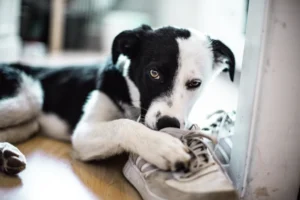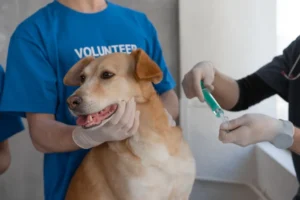Seeing our beloved dogs upset or anxious can be heart-wrenching, especially when it comes to separation anxiety. We can sometimes feel at a loss.
If you’re tired of coming home to a stressed-out dog or finding your favorite shoes chewed up, rest assured, we’ve got your back.
In this blog post, we’ll help you unravel the mystery behind your canine’s anxiety and explore effective strategies to help them feel more at ease. A happier dog means a happier home, and that’s what every pet owner wants, isn’t it?

What Is Separation Anxiety in Dogs?
Separation anxiety occurs when dogs become distressed due to being left alone or separated from their favorite humans.
It’s a common issue that can manifest in various ways, from excessive barking to destructive chewing. Remember, if your puppy is suffering from separation anxiety, it’s not a sign of disobedience. It’s an emotional response to being apart from their loved ones.
In the following sections, we’ll dive deeper into understanding and addressing this concern.
How Can You Recognize the Signs of Separation Anxiety?
Identifying separation anxiety in dogs involves observing changes in their behavior. Some common signs include:
- Excessive barking or howling when left alone
- Destructive chewing or scratching at doors and windows
- Pacing, panting, or drooling during your absence
- Accidents in the house despite being house-trained
- Clinginess or following you around when you’re home
Noticing these signs is the first step in helping your furry friend feel more comfortable when you’re not around. Stay tuned as we explore the reasons behind separation anxiety and how to address it effectively.
Why Do Dogs Develop Separation Anxiety?
Several factors contribute to separation anxiety in dogs.
One reason is a change in routine. Just like humans, dogs thrive on consistency. A sudden alteration in their daily schedule, such as a new job or moving to a new home, can trigger anxiety.
Another cause can be the loss of a family member. The absence of a close companion, whether human or another pet, may lead to emotional distress in dogs.
Additionally, the lack of socialization may also lead to separation anxiety. Puppies that haven’t been adequately socialized may be more prone to anxiety when left alone.
Lastly, dogs with a history of abandonment, rehoming, or neglect might be more susceptible to separation anxiety.
Understanding these underlying causes can help you better address your dog’s needs and provide appropriate support.
What Are the Risks of Untreated Separation Anxiety?
Ignoring separation anxiety can lead to a range of issues for both you and your dog:
- Destructive behavior. Anxious dogs may chew on furniture, dig holes, or scratch walls, leading to costly property damage.
- Noise complaints. Excessive barking or howling may disturb neighbors and even result in legal action.
- Self-injury. In extreme cases, dogs might hurt themselves while trying to escape confinement or cope with anxiety.
- Decline in overall well-being. Prolonged anxiety can negatively impact your dog’s physical health and emotional state, reducing their quality of life.
Addressing separation anxiety early on is crucial to prevent these risks and maintain a harmonious relationship with your canine companion.

How Can You Help Your Dog Cope With Separation Anxiety?
Helping your dog manage separation anxiety involves patience and consistency. Here are some strategies to guide you.
Create a Safe Space
Establish a designated area for your dog, where they feel secure and relaxed. This can be a cozy corner, a crate, or a separate room filled with their favorite toys, bedding, and comforting items.
Ensure the space is free of hazards and distractions, like loud noises or strong smells, to create an environment that promotes relaxation.
Establish a Consistent Routine
A predictable daily schedule helps your dog feel more secure. Set consistent times for feeding, walking, playtime, and departure/arrival, so your dog knows what to expect.
This consistency provides stability and can help reduce anxiety as your dog becomes more accustomed to your routine.
Apply Gradual Desensitization
Introduce your dog to short periods of alone time and gradually increase the duration. Start with a few minutes and work your way up to longer periods. This helps them become more comfortable with your absence.
Be patient and always monitor your dog’s progress, adjusting the time intervals based on their reactions.
Provide Training and Mental Stimulation
Teach your dog basic commands and practice obedience training. This not only keeps them mentally engaged but also helps establish trust and a stronger bond between you and your dog.
You can also train your dog to be quiet by following our guide. Additionally, consider using puzzle toys and interactive games to keep their mind occupied when you’re not around.
Use Positive Reinforcement
Reward your dog with praise, treats, or toys for displaying calm behavior when you leave and return home. This encourages positive associations with your departures and arrivals.
Be consistent with your rewards and avoid inadvertently reinforcing anxious behavior.
Exercise and Socialize Your Dog
Ensure your dog gets regular exercise and opportunities to interact with other dogs and people. This helps burn off excess energy and reduces stress, making it easier for them to cope with alone time.
Consider enrolling your dog in doggy daycare or arranging playdates with other dog owners to increase socialization.
Combining these strategies will significantly help your dog feel more at ease when you’re not around, improving their quality of life and your peace of mind.
When Should You Consider Seeking Professional Help?
It’s not easy to watch our dogs struggle with separation anxiety, and sometimes, despite our best efforts, the situation doesn’t improve.
If you’ve tried the strategies mentioned above and your dog’s separation anxiety doesn’t improve or worsens, don’t feel discouraged. It’s time to consult a professional.
A qualified veterinarian or a certified dog behaviorist can assess your dog’s specific needs and develop a tailored treatment plan. They can provide valuable insights and specialized techniques based on their expertise.
Remember, seeking professional help is a sign of love and dedication to your furry companion, as it ensures they receive the best possible care for their well-being.
Cesar Millan has some great tips on separation anxiety and how to help your dog:
FAQs
What are the symptoms of mild separation anxiety in dogs?
Mild separation anxiety in dogs may present as excessive barking, minor destructive behavior, or slight clinginess when you’re home.
Can separation anxiety lead to destructive behavior?
Yes, separation anxiety can result in destructive behavior, such as chewing furniture, scratching doors, or digging holes.
Is crate training helpful for dogs with separation anxiety?
Crate training can be beneficial for some dogs with separation anxiety, as it provides them with a safe, secure space when you’re not around.
How long does it take to help a dog overcome separation anxiety?
The time it takes to help a dog overcome separation anxiety varies depending on the severity of the condition and the effectiveness of the implemented strategies. It may take weeks or even months of consistent effort to see significant improvement.
Alex, a passionate animal lover, has experience in training and understanding animal behavior. As a proud pet parent to two dogs and three cats, he founded AnimalReport.net to share insights from animal experts and expand his knowledge of the animal kingdom.









